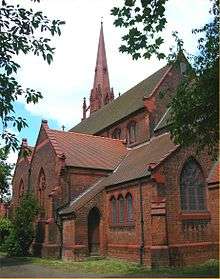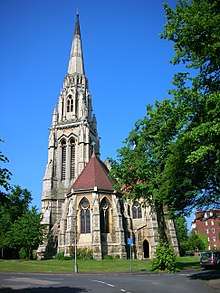J. A. Chatwin


Julius Alfred Chatwin FRIBA, ARBS, FSAScot (24 April 1830 – 6 June 1907), was a designer of buildings and the most prolific architect involved with the building and modification of churches in Birmingham, England, building or altering many of the parish churches in the city. He used both the Gothic and Classical styles. His designs always included all of the carvings and internal fittings.
Career
Born the son of John (a button manufacturer in Great Charles Street, Birmingham) and Harriet Chatwin, and educated at King Edward's School on New Street and the University of London, he was known by the name Alfred. He worked from 1846 as an architect for the largest builders in the country, Branson and Gwyther of Birmingham. He was articled to Charles Barry in 1851 and worked with Barry and Augustus Pugin on the Victoria Tower of the Houses of Parliament. He worked again for Gwyther personally on his enterprises in Llandudno, North Wales. In 1855 he opened an office on Bennett's Hill in Birmingham. He was, from 1866, architect to the Governors of King Edward's School and designed the first King Edward VI High School for Girls on New Street. From 1864 he became architect to Lloyds Bank for over thirty years.
From 1866 he worked with his son, Philip Boughton Chatwin (P. B. Chatwin) (1873–1964) who became his partner in 1897.
He was made a Fellow of the Royal Institute of British Architects (FRIBA) on 30 November 1863 and member of the Royal British Society of Sculptors (ARBS), Royal Society of Arts (RSA), and Fellow of the Royal Antiquary Society of Scotland.
He married at St James, Handsworth on 26 October 1869. He is buried with his wife Edith Isabella Chatwin and daughter Isabella Gertrude Chatwin in St Bartholomew's Church, Edgbaston. His gravestone also mentions his daughter Grace Constance Chatwin (cremated).
J.A. Chatwin was the great-grandfather of the writer Bruce Chatwin.
Works
He designed:
- Bingley Hall, 1850, now demolished[2]
- School House, Solihull School, 1882, Grade II listed[3]
- Most of the north side of Colmore Row after 1866
- Birmingham Greek Orthodox Cathedral - Dormition of the Mother of God and St Andrew (built as a Catholic Apostolic church), Grade II listed[4]
- St Clement, Nechells Park Road, 1857-9 (his first church)
- Holy Trinity Church, Birchfield, 1860-3 Grade II*
- The Joint Stock Bank (later Lloyds Bank, now the Old Joint Stock pub and Old Joint Stock Theatre), Temple Row West, 1862–64, Grade II listed[5]
- St Matthew's Church, Duddeston and Nechells 1866 addition of galleries to increase seating capacity.
- Knutsford Lodge, 25 Somerset Road, Grade II* listed[6]
- St Augustine's Church, Edgbaston, 1868, with 185 foot spire added later, Grade II* listed[7]
- St Lawrence's Church, Duddeston 1868 (demolished 1951)
- St Gabriel's Church, Deritend 1867 - 1869
- Christ Church, Summerfield, Edgbaston 1883 - 1885
- St. John's Church, Ladywood 1881 new chancel
- All Saints' Church, King's Heath 1883 north aisle
- St John, Bewdley Road, Kidderminster new nave 1890–94[8]
- King Edward VI Five Ways School 1882 - 1883[9]
- Lloyds Bank, Queen Square, Wolverhampton, Grade II listed (where he is commemorated by a blue plaque)[10]
- St Mark's Church, Washwood Heath 1890 - 1899
- St Martin in the Bull Ring, (except tower and spire), Grade II* listed[11]
- St Mary, Oldswinford, chancel 1898[12]
- St Mary, Bearwood Road, Bearwood, 1888[13]
- St. Mary's Church, Moseley (rebuilt), Grade II listed[14]
- St Mary the Virgin, Acocks Green, chancel 1894
- St Mary and St Ambrose, Pershore Road, Edgbaston, (a red brick and terracotta church, 1897–98), Grade II listed[15]
- Saints Peter and Paul - Aston Parish Church, 1879, (except tower and spire), Grade II* listed[16]
- St. Paul's, Lozells Road, Birmingham[17]
- St Philip's Cathedral, Birmingham (enlarged, with new chancel), Grade I listed[18]
- School and church, Catherine-de-Barnes, Solihull, 1880
- Work on Uppingham School, 1870
- St John the Evangelist's Church, Perry Barr 1888 new chancel, vestry and organ chamber
- Wolverhampton Art Gallery, 1882, Grade II listed[19]
- New Berry Hall,1880 & Berry Hall Lodge, Marsh Lane, Solihull, 1884, Grade II listed[20]
- St. Bartholomew's Church, Edgbaston 1885 new chancel, chapels and north arcade.
- Church of St. Michael and All Angels, Underwood 1890[21]
- Bishop Ryder Church, Birmingham 1894 new chancel
- St. John's Church, Kidderminster 1892–1904 new chancel, nave and aisles
- St James' Church, Handsworth 1895; rebuilding[22]
- St James' Church, Aston 1906 (demolished 1980)
- St Peter's Church, Handsworth 1907
References
- ↑ The Pub, The Old Joint Stock Bank, Retrieved 15 October 2015
- ↑ Little, Bryan (1971). Birmingham Buildings, The Architectural Story of a Midland City. ISBN 0-7153-5295-4.
- ↑ Historic England. "Solihull School (218312)". Images of England. Retrieved 13 February 2015.
- ↑ Historic England. "Birmingham Orthodox Cathedral (426244)". Images of England. Retrieved 13 February 2015.
- ↑ Historic England. "Joint Stock Bank (217670)". Images of England. Retrieved 13 February 2015.
- ↑ Historic England. "25 Somerset Road (217635)". Images of England. Retrieved 13 February 2015.
- ↑ Historic England. "St Augustine's Church, Edgbaston (217386)". Images of England. Retrieved 13 February 2015.
- ↑ Pevsner, Nikolaus (1968). Worcestershire. The Buildings of England. p. 206.
- ↑ "The Visit of Mr. Mundella to Birmingham. Opening of the Five Ways Grammar School". Birmingham Daily Post. England. 17 January 1883. Retrieved 1 February 2017 – via British Newspaper Archive. (Subscription required (help)).
- ↑ Historic England. "Details from image database (378535)". Images of England. Retrieved 13 February 2015.
- ↑ Historic England. "St Martin in the Bull Ring (216829)". Images of England. Retrieved 13 February 2015.
- ↑ Pevsner, Worcestershire, p. 228
- ↑ Pevsner, Worcestershire, p. 88
- ↑ Historic England. "St. Mary's Church, Moseley (217560)". Images of England. Retrieved 13 February 2015.
- ↑ Historic England. "SS Mary and Ambrose, Edgbaston (217497)". Images of England. Retrieved 13 February 2015.
- ↑ Historic England. "Saints Peter and Paul - Aston (217814)". Images of England. Retrieved 13 February 2015.
- ↑ "Celebration as restoration of gothic "Masterpiece" nears completion". English Heritage. 2008-12-10. Retrieved 2008-12-10.
- ↑ Historic England. "St Philip's Cathedral (217576)". Images of England. Retrieved 13 February 2015.
- ↑ Historic England. "Wolverhampton Art Gallery (378455)". Images of England. Retrieved 13 February 2015.
- ↑ Historic England. "New Berry Hall (218349)". Images of England. Retrieved 13 February 2015.
- ↑ More Churches in the Ashfield Area. Ashfield District Council.
- ↑ "Religious History - Churches built since 1800". A History of the County of Warwick: Volume 7. pp. 379–396. Retrieved 18 May 2014.
Sources
- Foster, Andy (2005). Birmingham. Pevsner Architectural Guides. ISBN 0-300-10731-5.
- Blue plaque in Wolverhampton
- St. Martin's in the Bull Ring. Church Guide. 1991. ISBN 0-85101-282-5.
- Incorporated Church Building Society - Church Plans Online
- Waterhouse, Rachel (1983). King Edward High School Birmingham 1883-1983.
- Noszlopy, George T. (1998). Jeremy Beach, ed. Public Sculpture of Birmingham including Sutton Coldfield. ISBN 0-85323-692-5.
- The Life Story of J. A. Chatwin FRIBA, FSA.Scot 1830-1907, P. B. Chatwin. Oxford University Press,. 1952.
- Bridges, Tim. Phillada Ballard, ed. Birmingham's Victorian and Edwardian Architects. Oblong. ISBN 978-0-9556576-2-7.
